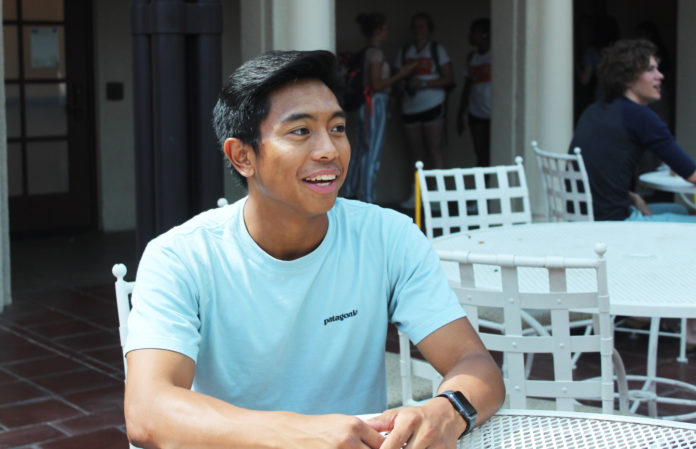
As OxSEA, Occidental’s ocean conservation and sustainability club, begins its first full year on campus, co-presidents Mia Jones (junior) and JP Flores (junior) are focusing the new club on its mission of environmental conservation action and education. The club is working with Boundless Brilliance to develop curricula for local schools according to Jones. In a partnership with the Southern California Marine Institute (SCMI), the club is also preparing to bring an ocean cleaning device, called a Seabin, to the Port of Los Angeles in San Pedro.
According to Jones, she and Flores were inspired to begin OxSEA as an outlet for young people to create real change for the environment. The need for action was especially clear after witnessing the shortcomings of environmental education within Occidental’s own community, according to Flores.
“I woke up one morning and walked through the quad and I saw trash everywhere,” Flores said. “I saw what was going on and knew something needed to change.”
Once Flores and Jones discovered the Seabin, the decision to start the club was easy, according to Jones.
“JP and I saw the Seabin and knew we needed to do this,” Jones said. “It wasn’t a question of deciding whether we wanted to do this, we just decided we were going to. We were trying to think of an avenue on which we could do it and we knew that we couldn’t do it all ourselves.”
According to Flores, the Seabin will be placed in the Port of Los Angeles and is able to filter trash, oils, microplastics and other pollutants. Flores said the Seabin can hold 50 pounds of debris.
“It’s basically a pool skimmer for the ocean,” Flores said.
SCMI will host the Seabin through their San Pedro lab and pay maintenance as well as travel costs for Occidental students between campus and San Pedro, according to Flores. Flores said he was relieved by how cooperative and supportive SCMI was to the project.
“I went down there and I was scared,” Flores said. “I sat in my car for ten minutes trying to pump myself up. I walked in and they took me back to the port and she basically said ‘Alright, pick a place, anywhere you want it’.”
OxSEA’s Seabin is fully funded by ASOC Senate and the ASOC Renewable Energy & Sustainability Fund, according to Jones. ASOC Senate provided half of the purchasing cost, according to ASOC VP of Finance Jordan Walker (junior).
“I really like the idea of students seeing issues in their biology classes, having the opportunity to work in labs to examine the effects, and finding solutions,” Walker said. “If they find those solutions we should empower them. I think ASOC having the funds to support something like this is what makes us the prime benefactor for students.”
The Seabin will also be valuable for the data it is able to gather on pollution and waste contents, according to Jones.
“Part of why SCMI was so eager for us to start was because they wanted our data,” Jones said.
Members of the club will work with SCMI to analyze the data gathered by the Seabin, according to Jones. OxSEA will also provide members opportunities for research and developing independent projects, both through SCMI and labs on campus. Having a large amount of club members is crucial in order to distribute the work needed to maintain the Seabin, according to Jones.
“We need as many passionate people as possible to keep the workload light,” Jones said. “This club will be low commitment as long as we have a lot of members.”
The Seabin is only one part of OxSEA’s broader goals, according to Flores.
“The mission of this club is to promote ocean conservation and sustainability, not just through this device but also through education,” Flores said. “We believe education is at the root of everything. We can use the Seabin as a tool to bring people in and see what it is collecting.”
OxSEA is planning to educate both Occidental’s community and young children about the impact they have on the environment and how to use that impact in a positive way, according to Flores. Jones said his primary motivation behind the formation of OxSEA was to provide young people an outlet to help.
“We thought it would be a good idea to expand it to not only the Oxy community and do education here, but we also thought of this aspect where we could go into the classrooms of young kids because that’s where it starts,” Jones said. “A lot of us have bad consumption habits, so if we can start at the root of it when these kids are learning habits and developing, then it will be so much more effective.”
Changing people’s existing behavior is difficult, but creating environmentally conscious habits from the start can be done, according to Jones. The curriculum model will be based on Peer Health Exchange, according to Jones.
“Since I’m in Peer Health Exchange, I’m really used to going into classrooms, talking to younger kids and teaching them about important things,” Jones said. “I teach sexual health, but the same techniques can be translated to environmental health and pollution education.”
OxSEA is working with Boundless Brilliance in hopes of taking their education curriculum into the classrooms of young students, according to Jones.
“The Seabin is going to help clean up and that will have a tangible effect,” Jones said. “But something that is just as important but not as visible is going to be through the kids and what we teach them.”
![]()



































